
The Sarmatians were a large confederation of ancient Iranian equestrian nomadic peoples who dominated the Pontic steppe from about the 3rd century BC to the 4th century AD.

A kurgan is a type of tumulus constructed over a grave, often characterized by containing a single human body along with grave vessels, weapons, and horses. Originally in use on the Pontic–Caspian steppe, kurgans spread into much of Central Asia and Eastern, Southeast, Western, and Northern Europe during the third millennium BC.

Circassia, also known as Zichia, was a country and a historical region in Eastern Europe. It spanned the western coastal portions of the North Caucasus, along the northeastern shore of the Black Sea. Circassia was conquered by the Russian Empire during the Russo-Circassian War (1763–1864), after which approximately 99.5-99.8% of the Circassian people were either exiled or massacred in the Circassian genocide.
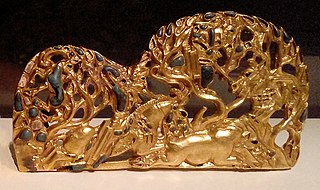
Scytho-Siberian art is the art associated with the cultures of the Scytho-Siberian world, primarily consisting of decorative objects such as jewellery, produced by the nomadic tribes of the Eurasian Steppe, with the western edges of the region vaguely defined by ancient Greeks. The identities of the nomadic peoples of the steppes is often uncertain, and the term "Scythian" should often be taken loosely; the art of nomads much further east than the core Scythian territory exhibits close similarities as well as differences, and terms such as the "Scytho-Siberian world" are often used. Other Eurasian nomad peoples recognised by ancient writers, notably Herodotus, include the Massagetae, Sarmatians, and Saka, the last a name from Persian sources, while ancient Chinese sources speak of the Xiongnu or Hsiung-nu. Modern archaeologists recognise, among others, the Pazyryk, Tagar, and Aldy-Bel cultures, with the furthest east of all, the later Ordos culture a little west of Beijing. The art of these peoples is collectively known as steppes art.
Oleg Nikolayevich Trubachyov was a Russian linguist. A researcher of the etymology of Slavic languages and Slavic onomastics, he was considered a specialist in historical linguistics and lexicography. He was a Doctor of Sciences in Philological Sciences, an academician of the Russian Academy of Sciences and served as the editor-in-chief of the Etimologiya yearbook. His works are on the etymology of Slavic languages and on East Slavic onomastics.

The Shoana church is a Christian church that belongs to the historical Alanian Diocese. The church was built at the end of the tenth century, and is located on the territory of modern Karachay-Cherkessia Republic, Russia. The building has a crossed-dome plan, with an inscribed cross, which is a variation of the North Zelenchuk Church.
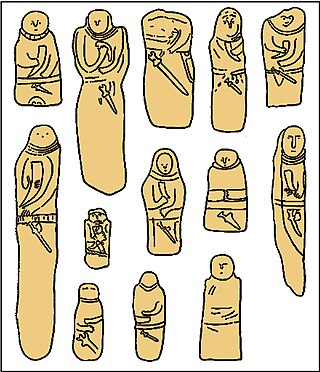
The Scythian religion refers to the mythology, ritual practices and beliefs of the Scythian cultures, a collection of closely related ancient Iranian peoples who inhabited Central Asia and the Pontic–Caspian steppe in Eastern Europe throughout Classical Antiquity, spoke the Scythian language, and which included the Scythians proper, the Cimmerians, the Sarmatians, the Alans, the Sindi, the Massagetae and the Saka.

The Mokshas comprise a Mordvinian ethnic group belonging to the Volgaic branch of the Finno-Ugric peoples. They live in Russia, mostly near the Volga and Moksha rivers, a tributary of the Oka River.

The art of Urartu refers to a historical and regional type of art from Urartu (Ararat), the ancient state of Western Asia which existed in the period from the 13th to the 6th centuries BC in the Armenian Highland. The art of Urartu was strongly influenced by nearby Assyria, the most prominent state of that period in the region. It peaked around the 8th century BC but was mostly looted, scattered and destroyed with the fall of Urartu about a century later.

The Etymological Dictionary of Slavic Languages: Proto-Slavic Lexical Stock is an etymological dictionary of the reconstructed Proto-Slavic lexicon. It has been continuously published since 1974 until present, in 43 volumes, making it one of the most comprehensive in the world.
Svetlana Yakovlevna Berzina was an important Russian Egyptologist. A doctor nauk of history (1977), she was a member of the board of the USSR-ARE Society (1987), was awarded the Medal "In Commemoration of the 850th Anniversary of Moscow" (1997), Honoured Worker of the Russian Federation (1999), Chief Research Officer of the Department of the History of Material Culture and Ancient Art of the East at the State Museum of the East, Moscow.
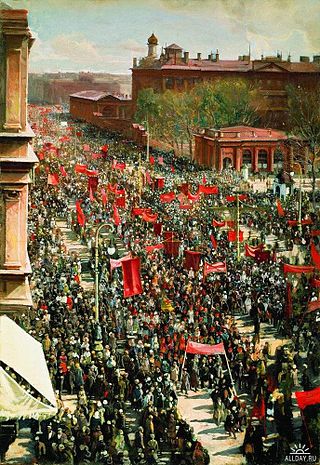
The fine art of Leningrad is an important component of Russian Soviet art—in the opinion of the art historians Vladimir Gusev and Vladimir Leniashin, "one of its most powerful currents". This widely used term embraces the creative lives and the achievements of several generations of Leningrad painters, sculptors, graphic artists and creators of decorative and applied art from 1917 to the early 1990s.

Alexei Rezepkin is a Russian archaeologist who made some significant archeological discoveries. He is a senior researcher at the Institute of History of Material Culture in St. Petersburg where he lives.
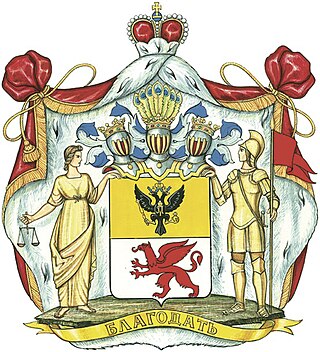
The House of Lopukhin was an old Russian noble family, most influential during the Russian Empire, forming one of the branches of the Sorokoumov-Glebov family.

The history of metallurgy in the Urals stands out to historians and economists as a separate stage in the history of Russian industry and covers the period from the 4th millennium BC to the present day. The emergence of the mining district is connected with the history of Ural metallurgy. The geography of the Ural metallurgy covers the territories of modern Perm Krai, Sverdlovsk Oblast, Udmurtia, Bashkortostan, Chelyabinsk Oblast and Orenburg Oblast.
Tyarsh or Tarsh, is an aul in the Dzheyrakhsky District of Ingushetia. It is part of the rural settlement of Olgeti. Tyarsh is the ancestral aul of Ingush clan (teip) Torshkhoy.

Bryk, is a mesa, a butte in Andropovsky District, Stavropol Krai, Russia, a complex geological and geomorphological natural monument of regional significance. Since 2013, it has been included in the list of Protected areas of Russia of regional significance in Stavropol Krai.

Tepe-Kermen is a butte and an early medieval settlement in the Bakhchysarai Raion of Crimea. It is located 7 km southeast of Bakhchysarai, and 2 km northeast of the settlement Kyz-Kermen. Its height is 544 meters. The easiest way to climb the mountain is from the northern slope. There are 2 paths leading to the top.
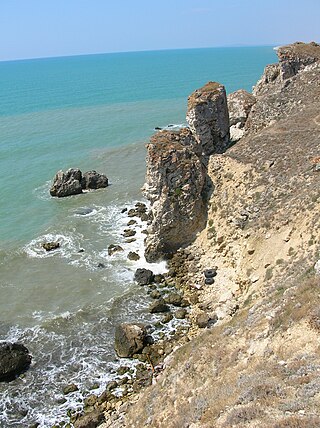
Opuk is a mountain 183 meters high, located on Opuk cape, on the southern tip of the Kerch Peninsula, in Crimea, the highest point in the area. The Opuk massif was declared the Opuk Nature Reserve in 1998. The slopes of Opuk mountain are a combination of stepped ledges, steep precipices, chasms and stone placers.

Titovskaya Sopka is a mountain massif, valuable natural-historical territory, complex geological natural monument of local significance. It is located on the southwestern outskirts of Chita, near the confluence of the Ingoda and Chitinka Rivers.


















